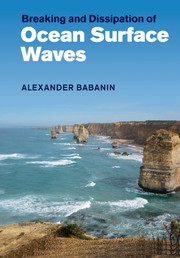Book contents
- Frontmatter
- Contents
- Preface
- 1 Introduction
- 2 Definitions for wave breaking
- 3 Detection and measurement of wave breaking
- 4 Fully nonlinear analytical theories for surface waves and numerical simulations of wave breaking
- 5 Wave-breaking probability
- 6 Wave-breaking severity
- 7 Energy dissipation across the wave spectrum
- 8 Non-dissipative effects of breaking on the wave field
- 9 Role of wave breaking in the air–sea interaction
- 10 Conclusions. What else do we need to know about wave breaking?
- References
- Index
6 - Wave-breaking severity
Published online by Cambridge University Press: 25 October 2011
- Frontmatter
- Contents
- Preface
- 1 Introduction
- 2 Definitions for wave breaking
- 3 Detection and measurement of wave breaking
- 4 Fully nonlinear analytical theories for surface waves and numerical simulations of wave breaking
- 5 Wave-breaking probability
- 6 Wave-breaking severity
- 7 Energy dissipation across the wave spectrum
- 8 Non-dissipative effects of breaking on the wave field
- 9 Role of wave breaking in the air–sea interaction
- 10 Conclusions. What else do we need to know about wave breaking?
- References
- Index
Summary
On many occasions earlier in this book, it has been mentioned and emphasised that knowledge of breaking severity is as important as is understanding the physics driving the breaking occurrence. While the latter, however, has received a lot of attention from the wave-research community lately, our information on breaking strength, its variability, environmental dependences and physics remains limited and fragmental.
If the breaking strength is defined as energy loss in a single breaking event (Section 2.7), then the breaking severity coefficient s can be identified in a number of ways, through measurement of the individual breaking wave (2.24), of the group where the breaking occurred (2.32), of spectra of the respective groups before and after the breaking (2.38) and of short waves modulated by the longer wave only (2.42). The magnitude of such a coefficient varies greatly, from s = 10% (Rapp & Melville, 1990, or even less as seen in Figure 6.3 below) up to 99% (2.31) based on the Black Sea estimates (see also Bonmarin, 1989; Babanin et al., 2010a, 2011a).
Such a range of change of course cannot be disregarded or substituted with some mean value in applications that involve the breaking severity. A typical application is the wave-energy dissipation function Sds employed in wave forecast models (2.21), (2.61) and (5.40).
- Type
- Chapter
- Information
- Breaking and Dissipation of Ocean Surface Waves , pp. 219 - 231Publisher: Cambridge University PressPrint publication year: 2011



